Genomic and Metabolomic Analysis of the Endophytic Fungus Fusarium sp. VM-40 Isolated from the Medicinal Plant Vinca minor
Abstract
1. Introduction
2. Materials and Methods
2.1. Fungus Isolation and Cultivation
2.2. Morphological Analysis and Internal Transcribed Spacer (ITS)-Based Identification
2.3. Whole Genome Sequencing and Assembly
2.3.1. DNA Extraction
2.3.2. Library Preparation and Sequencing
2.3.3. Computational Analysis
2.4. Comparative Analysis of Fungal Genomes and Phylogenetic Analysis
2.5. Gene Prediction and Annotation
2.6. Extraction of Secondary Metabolites and High-Resolution Liquid Chromatography-Mass Spectrometry (HR-LC-MS) Analysis
2.7. Data Processing and Analysis
3. Results and Discussion
3.1. Isolate VM-40 from Vinca minor Is a Fusarium
3.2. Genome Sequencing, Assembly, and Genomic Features
3.3. Multilocus Phylogeny and Comparative Analysis of the Fusarium sp. VM-40 Genome
3.4. The Genome of Fusarium sp. VM-40 Encodes for Various Enzymes of Biotechnological Interest
3.5. Fusarium sp. VM-40 Produces a Wide Range of Secondary Metabolites
3.6. Metabologenomic Analysis—Linking Secondary Metabolites to BGCs of Fusarium sp. VM-40
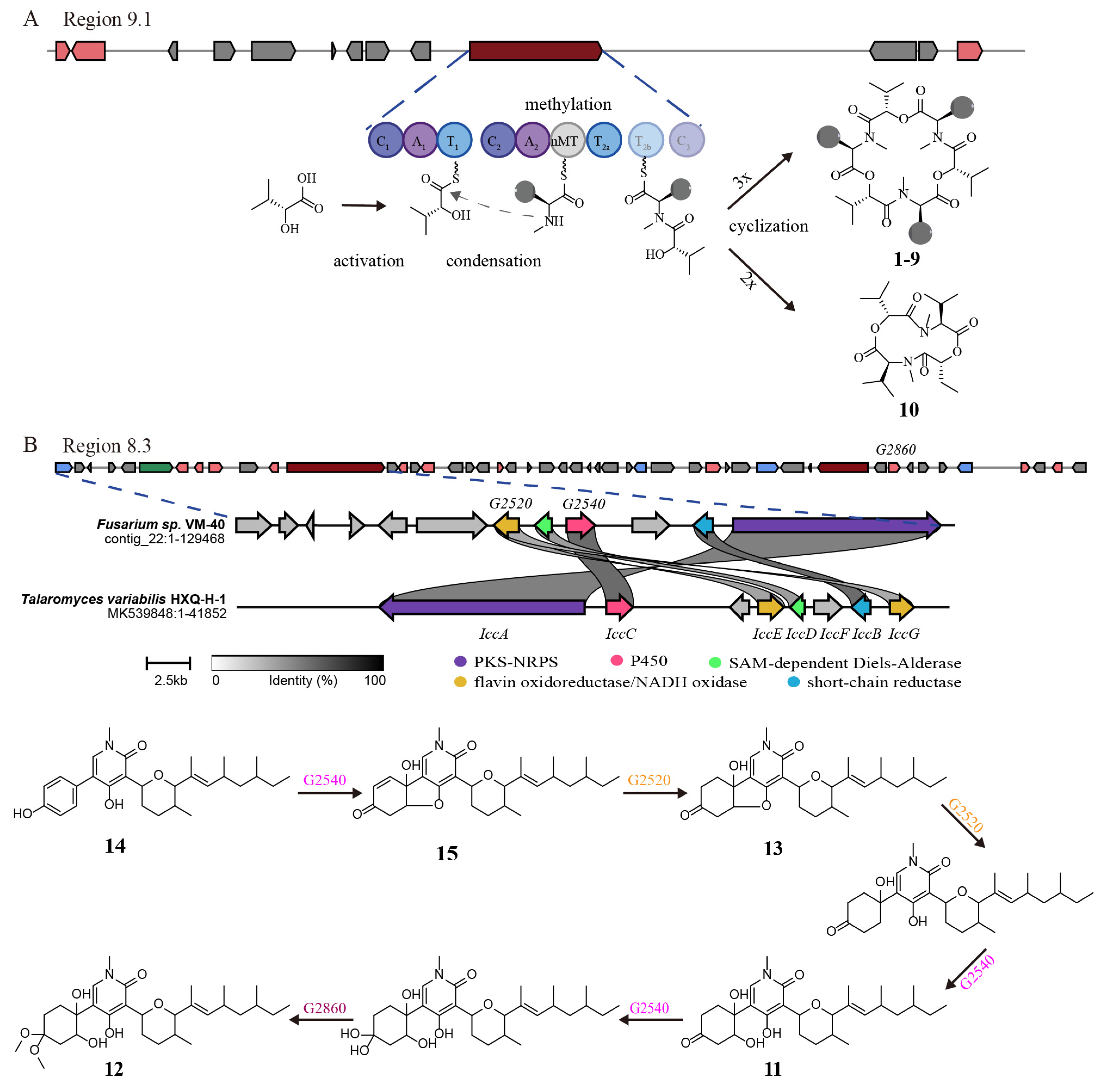
4. Conclusions
Supplementary Materials
Author Contributions
Funding
Institutional Review Board Statement
Informed Consent Statement
Data Availability Statement
Acknowledgments
Conflicts of Interest
Abbreviations
References
- Wen, J.; Okyere, S.K.; Wang, S.; Wang, J.; Xie, L.; Ran, Y.; Hu, Y. Endophytic Fungi: An Effective Alternative Source of Plant-Derived Compounds for Pharmacological Studies. J. Fungi 2022, 8, 205. [Google Scholar] [CrossRef]
- Ma, Y.-M.; Liang, X.-A.; Kong, Y.; Jia, B. Structural Diversity and Biological Activities of Indole Alkaloids from Fungi. J. Agric. Food Chem. 2016, 64, 6659–6671. [Google Scholar] [CrossRef]
- Jiang, C.-X.; Li, J.; Zhang, J.-M.; Jin, X.-J.; Yu, B.; Fang, J.-G.; Wu, Q.-X. Isolation, Identification, and Activity Evaluation of Chemical from Soil Fungus Fusarium avenaceum SF-1502 and Endophytic Fusarium proliferatum AF-04. J. Agric. Food Chem. 2019, 67, 1839–1846. [Google Scholar] [CrossRef] [PubMed]
- Hill, R.; Buggs, R.J.A.; Vu, D.T.; Gaya, E. Lifestyle Transitions in Fusarioid Fungi Are Frequent and Lack Clear Genomic Signatures. Mol. Biol. Evol. 2022, 39, msac085. [Google Scholar] [CrossRef]
- Chakravarthi, B.V.; Das, P.; Surendranath, K.; Karande, A.A.; Jayabaskaran, C. Production of paclitaxel by Fusarium solani isolated from Taxus celebica. J. Biosci. 2008, 33, 259–267. [Google Scholar] [CrossRef]
- Tang, P.J.; Zhang, Z.H.; Niu, L.L.; Gu, C.B.; Zheng, W.Y.; Cui, H.C.; Yuan, X.H. Fusarium solani G6, a Novel Vitexin-Producing Endophytic Fungus: Characterization, Yield Improvement and Osteoblastic Proliferation Activity. Biotechnol. Lett. 2021, 43, 1371–1383. [Google Scholar] [CrossRef] [PubMed]
- Hidayat, I. Three Quinine and Cinchonidine Producing Fusarium Species from Indonesia. Curr. Res. Environ. Appl. Mycol. 2016, 6, 20–34. [Google Scholar] [CrossRef]
- Abro, M.A.; Sun, X.; Li, X.; Jatoi, G.H.; Guo, L.D. Biocontrol Potential of Fungal Endophytes against Fusarium oxysporum f. sp. cucumerinum Causing Wilt in Cucumber. Plant Pathol. J. 2019, 35, 598–608. [Google Scholar] [CrossRef]
- Rojas, E.C.; Jensen, B.; Jørgensen, H.J.L.; Latz, M.A.C.; Esteban, P.; Ding, Y.; Collinge, D.B. Selection of Fungal Endophytes with Biocontrol Potential against Fusarium Head Blight in Wheat. Biol. Control 2020, 144, 104222. [Google Scholar] [CrossRef]
- Noel, Z.A.; Roze, L.V.; Breunig, M.; Trail, F. Endophytic Fungi as a Promising Biocontrol Agent to Protect Wheat from Fusarium graminearum Head Blight. Plant Dis. 2022, 106, 595–602. [Google Scholar] [CrossRef]
- de Lamo, F.J.; Takken, F.L.W. Biocontrol by Fusarium oxysporum Using Endophyte-Mediated Resistance. Front. Plant Sci. 2020, 11, 37. [Google Scholar] [CrossRef] [PubMed]
- Saito, H.; Sasaki, M.; Nonaka, Y.; Tanaka, J.; Tokunaga, T.; Kato, A.; Thu Thuy, T.T.; Vang, L.V.; Tuong, L.M.; Kanematsu, S.; et al. Spray Application of Nonpathogenic Fusaria onto Rice Flowers Controls Bakanae Disease (Caused by Fusarium fujikuroi) in the next Plant Generation. Appl. Environ. Microbiol. 2021, 87, e01959-20. [Google Scholar] [CrossRef] [PubMed]
- Li, M.; Yu, R.; Bai, X.; Wang, H.; Zhang, H. Fusarium: A Treasure Trove of Bioactive Secondary Metabolites. Nat. Prod. Rep. 2020, 37, 1568–1588. [Google Scholar] [CrossRef] [PubMed]
- Lyu, H.-N.; Liu, H.-W.; Keller, N.P.; Yin, W.-B. Harnessing Diverse Transcriptional Regulators for Natural Product in Fungi. Nat. Prod. Rep. 2020, 37, 6–16. [Google Scholar] [CrossRef]
- Woodcraft, C.; Chooi, Y.-H.; Roux, I. The Expanding CRISPR Toolbox for Natural Product Discovery and Engineering in Filamentous Fungi. Nat. Prod. Rep. 2023, 40, 158–173. [Google Scholar] [CrossRef]
- Scherlach, K.; Hertweck, C. Mining and Unearthing Hidden Biosynthetic Potential. Nat. Commun. 2021, 12, 3864. [Google Scholar] [CrossRef]
- Pillay, L.C.; Nekati, L.; Makhwitine, P.J.; Ndlovu, S.I. Epigenetic Activation of Silent Biosynthetic Gene Clusters in Endophytic Fungi Using Small Molecular Modifiers. Front. Microbiol. 2022, 13, 815008. [Google Scholar] [CrossRef]
- Feng, T.; Wei, C.; Deng, X.; Chen, D.; Wen, Z.; Xu, J. Epigenetic Manipulation Induced Production of Immunosuppressive and Cytochalasins from the Mangrove Endophytic Fungus Phomopsis asparagi DHS-48. Mar. Drugs 2022, 20, 616. [Google Scholar] [CrossRef]
- El-Hawary, S.S.; Sayed, A.M.; Mohammed, R.; Hassan, H.M.; Zaki, M.A.; Rateb, M.E.; Mohammed, T.A.; Amin, E.; Abdelmohsen, U.R. Epigenetic Modifiers Induce Bioactive Phenolic Metabolites in the Marine-Derived Fungus Penicillium brevicompactum. Mar. Drugs 2018, 16, 253. [Google Scholar] [CrossRef]
- Albrectsen, B.R.; Bjorken, L.; Varad, A.; Hagner, A.; Wedin, M.; Karlsson, J.; Jansson, S. Endophytic Fungi in European Aspen (Populus tremula) Leaves-Diversity, Detection, and a Suggested Correlation with Herbivory Resistance. Fungal Divers. 2010, 41, 17–28. [Google Scholar] [CrossRef]
- Wick, R.R.; Judd, L.M.; Holt, K.E. Performance of Neural Network Basecalling Tools for Oxford Nanopore Sequencing. Genome Biol. 2019, 20, 129. [Google Scholar] [CrossRef] [PubMed]
- De Coster, W.; D’Hert, S.; Schultz, D.T.; Cruts, M.; Van Broeckhoven, C. NanoPack: Visualizing and Processing Long-Read Sequencing Data. Bioinformatics 2018, 34, 2666–2669. [Google Scholar] [CrossRef] [PubMed]
- Gurevich, A.; Saveliev, V.; Vyahhi, N.; Tesler, G. QUAST: Quality Assessment Tool for Genome Assemblies. Bioinformatics 2013, 29, 1072–1075. [Google Scholar] [CrossRef] [PubMed]
- Wick, R.R.; Schultz, M.B.; Zobel, J.; Holt, K.E. Bandage: Interactive Visualization of de Novo Genome Assemblies. Bioinformatics 2015, 31, 3350–3352. [Google Scholar] [CrossRef]
- Vaser, R.; Sović, I.; Nagarajan, N.; Šikić, M. Fast and Accurate de Novo Genome Assembly from Long Uncorrected Reads. Genome Res. 2017, 27, 737–746. [Google Scholar] [CrossRef] [PubMed]
- Humann, J.L.; Lee, T.; Ficklin, S.; Main, D. Structural and Functional Annotation of Eukaryotic Genomes with GenSAS. In Methods in Molecular Biology; Humana Press Inc.: Totowa, NJ, USA, 2019; Volume 1962, pp. 29–51. [Google Scholar]
- Chernomor, O.; Von Haeseler, A.; Minh, B.Q. Terrace Aware Data Structure for Phylogenomic Inference from Supermatrices. Syst. Biol. 2016, 65, 997–1008. [Google Scholar] [CrossRef]
- Emms, D.M.; Kelly, S. OrthoFinder: Phylogenetic Orthology Inference for Comparative Genomics. Genome Biol. 2019, 20, 238. [Google Scholar] [CrossRef]
- Katoh, K.; Misawa, K.; Kuma, K.-I.; Miyata, T. MAFFT: A Novel Method for Rapid Multiple Sequence Alignment Based on Fast Fourier Transform. Nucleic Acids Res. 2002, 30, 3059–3066. [Google Scholar] [CrossRef]
- Price, M.N.; Dehal, P.S.; Arkin, A.P. Fasttree: Computing Large Minimum Evolution Trees with Profiles Instead of a Distance Matrix. Mol. Biol. Evol. 2009, 26, 1641–1650. [Google Scholar] [CrossRef]
- Emms, D.M.; Kelly, S. STRIDE: Species Tree Root Inference from Gene Duplication Events. Mol. Biol. Evol. 2017, 34, 3267–3278. [Google Scholar] [CrossRef]
- Crous, P.W.; Lombard, L.; Sandoval-Denis, M.; Seifert, K.A.; Schroers, H.-J.; Chaverri, P.; Gene, J.; Guarro, J.; Hirooka, Y.; Bensch, K.; et al. Fusarium: More than a Node or a Foot-Shaped Basal Cell. Stud. Mycol. 2021, 98, 100116. [Google Scholar] [CrossRef] [PubMed]
- Chan, P.P.; Lin, B.Y.; Mak, A.J.; Lowe, T.M. TRNAscan-SE 2.0: Improved Detection and Functional Classification of Transfer RNA Genes. Nucleic Acids Res. 2021, 49, 9077–9096. [Google Scholar] [CrossRef] [PubMed]
- Paysan-Lafosse, T.; Blum, M.; Chuguransky, S.; Grego, T.; Pinto, B.L.; Salazar, G.A.; Bileschi, M.L.; Bork, P.; Bridge, A.; Colwell, L.; et al. InterPro in 2022. Nucleic Acids Res. 2023, 51, 418–427. [Google Scholar] [CrossRef] [PubMed]
- Zhang, H.; Yohe, T.; Huang, L.; Entwistle, S.; Wu, P.; Yang, Z.; Busk, P.K.; Xu, Y.; Yin, Y. DbCAN2: A Meta Server for Automated Carbohydrate-Active Enzyme. Nucleic Acids Res. 2018, 46, W95–W101. [Google Scholar] [CrossRef] [PubMed]
- Blin, K.; Shaw, S.; Augustijn, H.E.; Reitz, Z.L.; Biermann, F.; Alanjary, M.; Fetter, A.; Terlouw, B.R.; Metcalf, W.W.; Helfrich, E.J.N.; et al. AntiSMASH 7.0: New and Improved Predictions for Detection, Regulation, Chemical Structures and Visualisation. Nucleic Acids Res. 2023, gkad344. [Google Scholar] [CrossRef] [PubMed]
- Wang, M.; Carver, J.J.; Phelan, V.V.; Sanchez, L.M.; Garg, N.; Peng, Y.; Nguyen, D.D.; Watrous, J.; Kapono, C.A.; Luzzatto-Knaan, T.; et al. Sharing and Community Curation of Mass Spectrometry Data with Global Products Social Molecular Networking. Nat. Biotechnol. 2016, 34, 828–837. [Google Scholar] [CrossRef] [PubMed]
- Shannon, P.; Markiel, A.; Ozier, O.; Baliga, N.S.; Wang, J.T.; Ramage, D.; Amin, N.; Schwikowski, B.; Ideker, T. Cytoscape: A Software Environment for Integrated Models of Biomolecular Networks. Genome Res. 2003, 13, 2498–2504. [Google Scholar] [CrossRef]
- Vas, Á.; Gulyás, B. Eburnamine Derivatives and the Brain. Med. Res. Rev. 2005, 25, 737–757. [Google Scholar] [CrossRef]
- Bahadori, F.; Topçu, G.; Boğa, M.; Türkekul, A.; Kolak, U.; Kartal, M. Indole Alkaloids from Vinca Major. and V. Minor. Growing in Turkey. Nat. Prod. Commun. 2012, 7, 731–734. [Google Scholar] [CrossRef]
- Leylaie, S.; Zafari, D. Antiproliferative and Antimicrobial Activities of Secondary Metabolites and Phylogenetic Study of Endophytic Trichoderma Species From Vinca Plants. Front. Microbiol. 2018, 9, 1484. [Google Scholar] [CrossRef]
- Yin, H.; Sun, Y.H. Vincamine-Producing Endophytic Fungus Isolated from Vinca minor. Phytomedicine 2011, 18, 802–805. [Google Scholar] [CrossRef] [PubMed]
- Stępień, Ł. Plant-Pathogenic Fusarium Species. J. Fungi 2023, 9, 13. [Google Scholar] [CrossRef] [PubMed]
- Ahmed, A.M.; Mahmoud, B.K.; Millán-Aguiñaga, N.; Abdelmohsen, U.R.; Fouad, M.A. The Endophytic Fusarium Strains: A Treasure Trove of Natural Products. RSC Adv. 2023, 13, 1339–1369. [Google Scholar] [CrossRef]
- O’Donnell, K.; Ward, T.J.; Robert, V.A.R.G.; Crous, P.W.; Geiser, D.M.; Kang, S. DNA Sequence-Based Identification of Fusarium: Current Status and Future Directions. Phytoparasitica 2015, 43, 583–595. [Google Scholar] [CrossRef]
- Garron, M.-L.; Henrissat, B. The Continuing Expansion of CAZymes and Their Families. Curr. Opin. Chem. Biol. 2019, 53, 82–87. [Google Scholar] [CrossRef] [PubMed]
- Looi, H.K.; Toh, Y.F.; Yew, S.M.; Na, S.L.; Tan, Y.C.; Chong, P.S.; Khoo, J.S.; Yee, W.Y.; Ng, K.P.; Kuan, C.S. Genomic Insight into Pathogenicity of Dematiaceous Fungus Corynespora cassiicola. PeerJ 2017, 5, e2841. [Google Scholar] [CrossRef] [PubMed]
- Terlouw, B.R.; Blin, K.; Navarro-Muñoz, J.C.; Avalon, N.E.; Chevrette, M.G.; Egbert, S.; Lee, S.; Meijer, D.; Recchia, M.J.J.; Reitz, Z.L.; et al. MIBiG 3.0: A Community-Driven Effort to Annotate Experimentally Validated Biosynthetic Gene Clusters. Nucleic Acids Res. 2023, 51, D603–D610. [Google Scholar] [CrossRef]
- Hoogendoorn, K.; Barra, L.; Waalwijk, C.; Dickschat, J.S.; van der Lee, T.A.J.; Medema, M.H. Evolution and Diversity of Biosynthetic Gene Clusters in Fusarium. Front. Microbiol. 2018, 9, 1158. [Google Scholar] [CrossRef]
- Yin, W.-B.; Baccile, J.A.; Bok, J.W.; Chen Yiming and Keller, N.P.; Schroeder, F.C. A Nonribosomal Peptide Synthetase-Derived Iron(III) Complex from the Pathogenic Fungus Aspergillus fumigatus. J. Am. Chem. Soc. 2013, 135, 2064–2067. [Google Scholar] [CrossRef]
- Wollenberg, R.D.; Sondergaard, T.E.; Nielsen, M.R.; Knutsson, S.; Pedersen, T.B.; Westphal, K.R.; Wimmer, R.; Gardiner, D.M.; Sørensen, J.L. There It Is! Fusarium pseudograminearum Did Not Lose the Fusaristatin Gene Cluster after All. Fungal Biol. 2019, 123, 10–17. [Google Scholar] [CrossRef]
- Khudhair, M.; Kazan, K.; Thatcher, L.F.; Obanor, F.; Rusu, A.; Sørensen, J.L.; Wollenberg, R.D.; McKay, A.; Giblot-Ducray, D.; Simpfendorfer, S.; et al. Fusaristatin A Production Negatively Affects the Growth and Aggressiveness of the Wheat Pathogen Fusarium pseudograminearum. Fungal Genet. Biol. 2020, 136, 103314. [Google Scholar] [CrossRef] [PubMed]
- Kakule, T.B.; Sardar, D.; Lin, Z.; Schmidt, E.W. Two Related Pyrrolidinedione Synthetase Loci in Fusarium heterosporum ATCC 74349 Produce Divergent Metabolites. ACS Chem. Biol. 2013, 8, 1549–1557. [Google Scholar] [CrossRef]
- Li, Y.; He, N.; Luo, M.; Hong, B.; Xie, Y. Application of Untargeted Tandem Mass Spectrometry with Molecular for Detection of Enniatins and Beauvericins from Complex. J. Chromatogr. A 2020, 1634, 461626. [Google Scholar] [CrossRef] [PubMed]
- A. Abdelhakim, I.; Bin Mahmud, F.; Motoyama, T.; Futamura, Y.; Takahashi, S.; Osada, H. Dihydrolucilactaene, a Potent Antimalarial Compound from Fusarium Sp. RK97-94. J. Nat. Prod. 2022, 85, 63–69. [Google Scholar] [CrossRef]
- Supothina, S.; Isaka, M.; Kirtikara, K.; Tanticharoen, M.; Thebtaranonth, Y. Enniatin Production by the Entomopathogenic Fungus Verticillium hemipterigenum BCC 1449. J. Antibiot. 2004, 57, 732–738. [Google Scholar] [CrossRef] [PubMed]
- Hiraga, K.; Yamamoto, S.; Fukuda, H.; Hamanaka, N.; Oda, K. Enniatin Has a New Function as an Inhibitor of Pdr5p, One of the ABC Transporters in Saccharomyces cerevisiae. Biochem. Biophys. Res. Commun. 2005, 328, 1119–1125. [Google Scholar] [CrossRef]
- Tomoda, H.; Huang, X.-H.; Cao, J.; Nishida, H.; Nagao, R.; Okuda, S.; Omura, S.; Arai, H.; Inoue, K. Inhibition of Acyl-coa: Cholesterol acyltransferase Activity by Cyclodepsipeptide Antibiotics. J. Antibiot. 1992, 45, 1626–1632. [Google Scholar] [CrossRef]
- Süssmuth, R.; Müller, J.; Von Döhren, H.; Molnár, I. Fungal Cyclooligomer Depsipeptides: From Classical Biochemistry to Combinatorial Biosynthesis. Nat. Prod. Rep. 2011, 28, 99–124. [Google Scholar] [CrossRef]
- Kamyar, M.; Rawnduzi, P.; Studenik, C.R.; Kouri, K.; Lemmens-Gruber, R. Investigation of the Electrophysiological Properties of Enniatins. Arch. Biochem. Biophys. 2004, 429, 215–223. [Google Scholar] [CrossRef]
- Sun, W.-J.; Zhu, H.-T.; Zhang, T.-Y.; Zhang Meng-Yue and Wang, D.; Yang, C.-R.; Zhang, Y.-X.; Zhang, Y.-J. Two New Alkaloids from Fusarium tricinctum SYPF 7082, an Endophyte from the Root of Panax notoginseng. Nat. Prod. Bioprospect 2018, 8, 391–396. [Google Scholar] [CrossRef]
- Breinholt, J.; Ludvigsen, S.; Rassing, B.R.; Rosendahl, C.N.; Nielsen, S.E.; Olsen, C.E. Oxysporidinone: A Novel, Antifungal N-Methyl-4-Hydroxy-2-Pyridone from Fusarium oxysporum. J. Nat. Prod. 1997, 60, 33–35. [Google Scholar] [CrossRef] [PubMed]
- Jayasinghe, L.; Abbas, H.K.; Jacob, M.R.; Herath, W.; Nanayakkara, N.P.D. N-Methyl-4-Hydroxy-2-Pyridinone Analogues from Fusarium oxysporum. J. Nat. Prod. 2006, 69, 439–442. [Google Scholar] [CrossRef] [PubMed]
- Li, D.; Wang, W.; Xu, K.; Li, J.; Long, B.; Li, Z.; Tan, G.; Yu, X. Elucidation of a Dearomatization Route in the Biosynthesis of Oxysporidinone Involving a TenA-like Cytochrome P450 Enzyme. Angew. Chem. Int. Ed. 2023, 135, e202301976. [Google Scholar] [CrossRef]
- Abdelhakim, I.A.; Motoyama, T.; Nogawa, T.; Mahmud, F.B.; Futamura, Y.; Takahashi, S.; Osada, H. Isolation of New Lucilactaene Derivatives from P450 Monooxygenase and Aldehyde Dehydrogenase Knockout Fusarium Sp. RK97-94 Strains and Their Biological Activities. J. Antibiot. 2022, 75, 361–374. [Google Scholar] [CrossRef]
- Kato, S.; Motoyama, T.; Futamura, Y.; Uramoto, M.; Nogawa, T.; Hayashi, T.; Hirota, H.; Tanaka, A.; Takahashi-Ando, N.; Kamakura, T.; et al. Biosynthetic Gene Cluster Identification and Biological Activity of Lucilactaene from Fusarium Sp. RK97-94. Biosci. Biotechnol. Biochem. 2020, 84, 1303–1307. [Google Scholar] [CrossRef]
- Sørensen, J.L.; Sondergaard, T.E.; Covarelli, L.; Fuertes, P.R.; Hansen, F.T.; Frandsen, R.J.N.; Saei, W.; Lukassen, M.B.; Wimmer, R.; Nielsen, K.F.; et al. Identification of the Biosynthetic Gene Clusters for the Lipopeptides Fusaristatin A and W493 B in Fusarium graminearum and F. pseudograminearum. J. Nat. Prod. 2014, 77, 2619–2625. [Google Scholar] [CrossRef]
- Gilchrist, C.L.M.; Chooi, Y.H. Clinker & Clustermap.Js: Automatic Generation of Gene Cluster Comparison Figures. Bioinformatics 2021, 37, 2473–2475. [Google Scholar] [CrossRef]
- Mesny, F.; Miyauchi, S.; Thiergart, T.; Pickel, B.; Atanasova, L.; Karlsson, M.; Hüttel, B.; Barry, K.W.; Haridas, S.; Chen, C.; et al. Genetic determinants of endophytism in the Arabidopsis root mycobiome. Nat. Commun. 2021, 12, 7227. [Google Scholar] [CrossRef]
- Nordberg, H.; Cantor, M.; Dusheyko, S.; Hua, S.; Poliakov, A.; Shabalov, I.; Smirnova, T.; Grigoriev, I.V.; Dubchak, I. The genome portal of the Department of Energy Joint Genome Institute: 2014 updates. Nucleic Acids Res. 2014, 42, 26–31. [Google Scholar] [CrossRef]
- Urban, M.; King, R.; Andongabo, A.; Maheswari, U.; Pedro, H.; Kersey, P.; Hammond-Kosack, K. First draft genome sequence of a UK strain (UK99) of Fusarium culmorum. Genome Announc. 2016, 4, e00771-16. [Google Scholar] [CrossRef]
- Wiemann, P.; Sieber, C.M.; von Bargen, K.W.; Studt, L.; Niehaus, E.M.; Espino, J.J.; Huß, K.; Michielse, C.B.; Albermann, S.; Wagner, D.; et al. Deciphering the cryptic genome: Genome-wide analyses of the rice pathogen Fusarium fujikuroi reveal complex regulation of secondary metabolism and novel metabolites. PLoS Pathog. 2013, 9, e1003475. [Google Scholar] [CrossRef] [PubMed]
- Wang, B.; Yu, H.; Jia, Y.; Dong, Q.; Steinberg, C.; Alabouvette, C.; Edel-Hermann, V.; Kistler, H.C.; Ye, K.; Ma, L.J.; et al. Chromosome-scale genome assembly of Fusarium oxysporum strain Fo47, a fungal endophyte and biocontrol agent. Mol. Plant Microbe. Interact. 2020, 33, 1108–1111. [Google Scholar] [CrossRef] [PubMed]
- Vanheule, A.; Audenaert, K.; Warris, S.; van de Geest, H.; Schijlen, E.; Höfte, M.; De Saeger, S.; Haesaert, G.; Waalwijk, C.; van der Lee, T. Living apart together: Crosstalk between the core and supernumerary genomes in a fungal plant pathogen. BMC Genom. 2016, 23, 670. [Google Scholar] [CrossRef] [PubMed]
- Niehaus, E.M.; Münsterkötter, M.; Proctor, R.H.; Brown, D.W.; Sharon, A.; Idan, Y.; Oren-Young, L.; Sieber, C.M.; Novák, O.; Pěnčík, A.; et al. Comparative “Omics” of the Fusarium fujikuroi species complex highlights differences in genetic potential and metabolite Synthesis. Genome Biol. Evol. 2016, 31, 3574–3599. [Google Scholar] [CrossRef] [PubMed]
- Gardiner, D.M.; McDonald, M.C.; Covarelli, L.; Solomon, P.S.; Rusu, A.G.; Marshall, M.; Kazan, K.; Chakraborty, S.; McDonald, B.A.; Manners, J.M. Comparative pathogenomics reveals horizontally acquired novel virulence genes in fungi infecting cereal hosts. PLoS Pathog. 2012, 8, e1002952. [Google Scholar] [CrossRef]
- Coleman, J.J.; Rounsley, S.D.; Rodriguez-Carres, M.; Kuo, A.; Wasmann, C.C.; Grimwood, J.; Schmutz, J.; Taga, M.; White, G.J.; Zhou, S.; et al. The genome of Nectria haematococca: Contribution of supernumerary chromosomes to gene expansion. PLoS Genet. 2009, 5, e1000618. [Google Scholar] [CrossRef]
- Temporini, E.D.; VanEtten, H.D. An analysis of the phylogenetic distribution of the pea pathogenicity genes in Nectria haematococca MPVI supports the hypothesis of their origin by horizontal transfer and uncovers a potentially new pathogen of garden pea: Neocosmospora boniensis. Curr. Genet. 2004, 46, 29–36. [Google Scholar] [CrossRef]
- Udagawa, S.I.; Horie, Y.; Cannon, P.F. Two new species of Neocosmospora from Japan, with a key to the currently accepted species. Sydowia 1989, 41, 349–359. [Google Scholar]
- Ma, L.J.; van der Does, H.C.; Borkovich, K.A.; Coleman, J.J.; Daboussi, M.J.; Di Pietro, A.; Dufresne, M.; Freitag, M.; Grabherr, M.; Henrissat, B.; et al. Comparative genomics reveals mobile pathogenicity chromosomes in Fusarium. Nature 2010, 464, 367–373. [Google Scholar] [CrossRef]
- Gómez-Cortecero, A.; Harrison, R.J.; Armitage, A.D. Draft genome sequence of a European isolate of the apple canker pathogen Neonectria ditissima. Genome Announc. 2015, 3, e01243-15. [Google Scholar] [CrossRef]
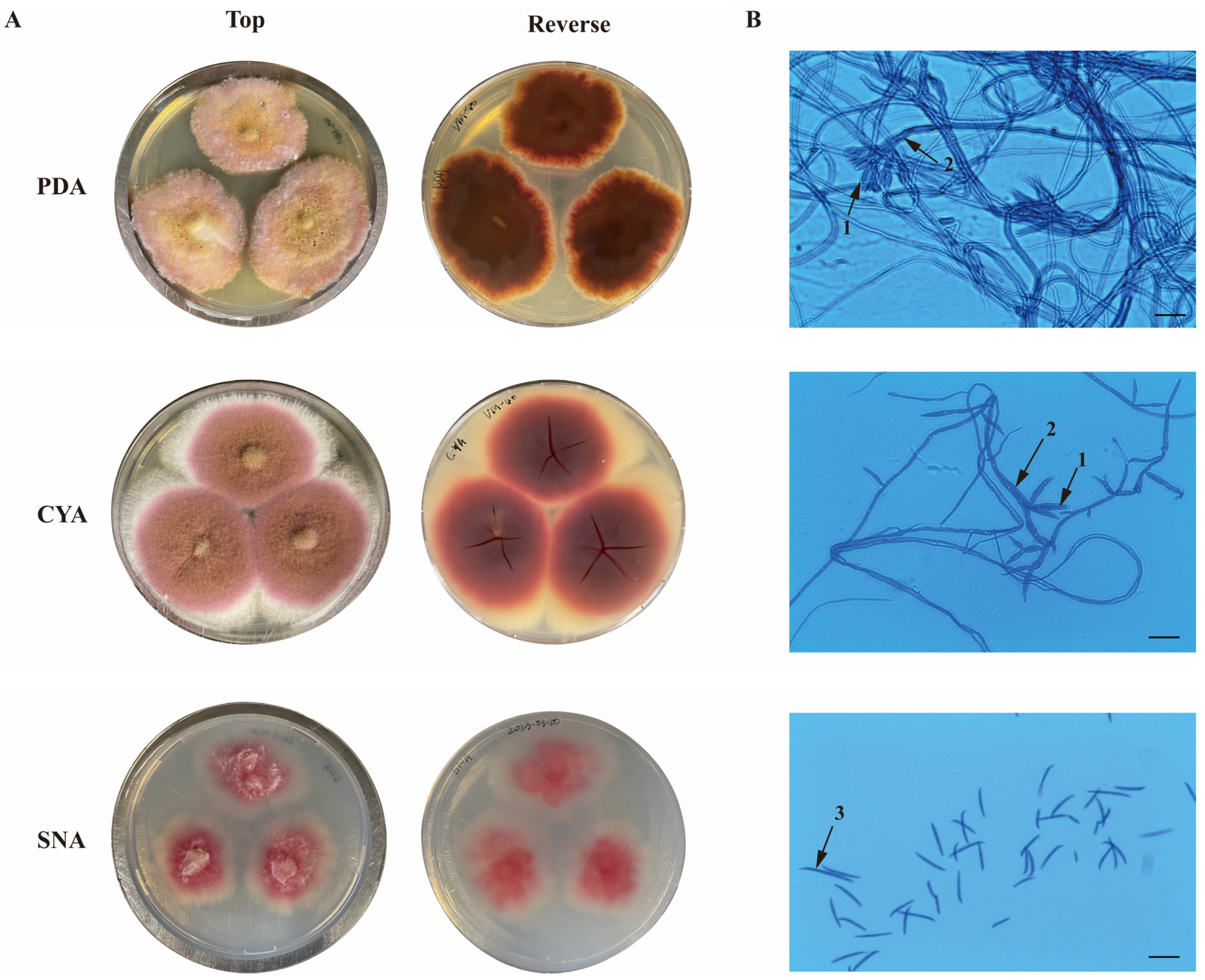
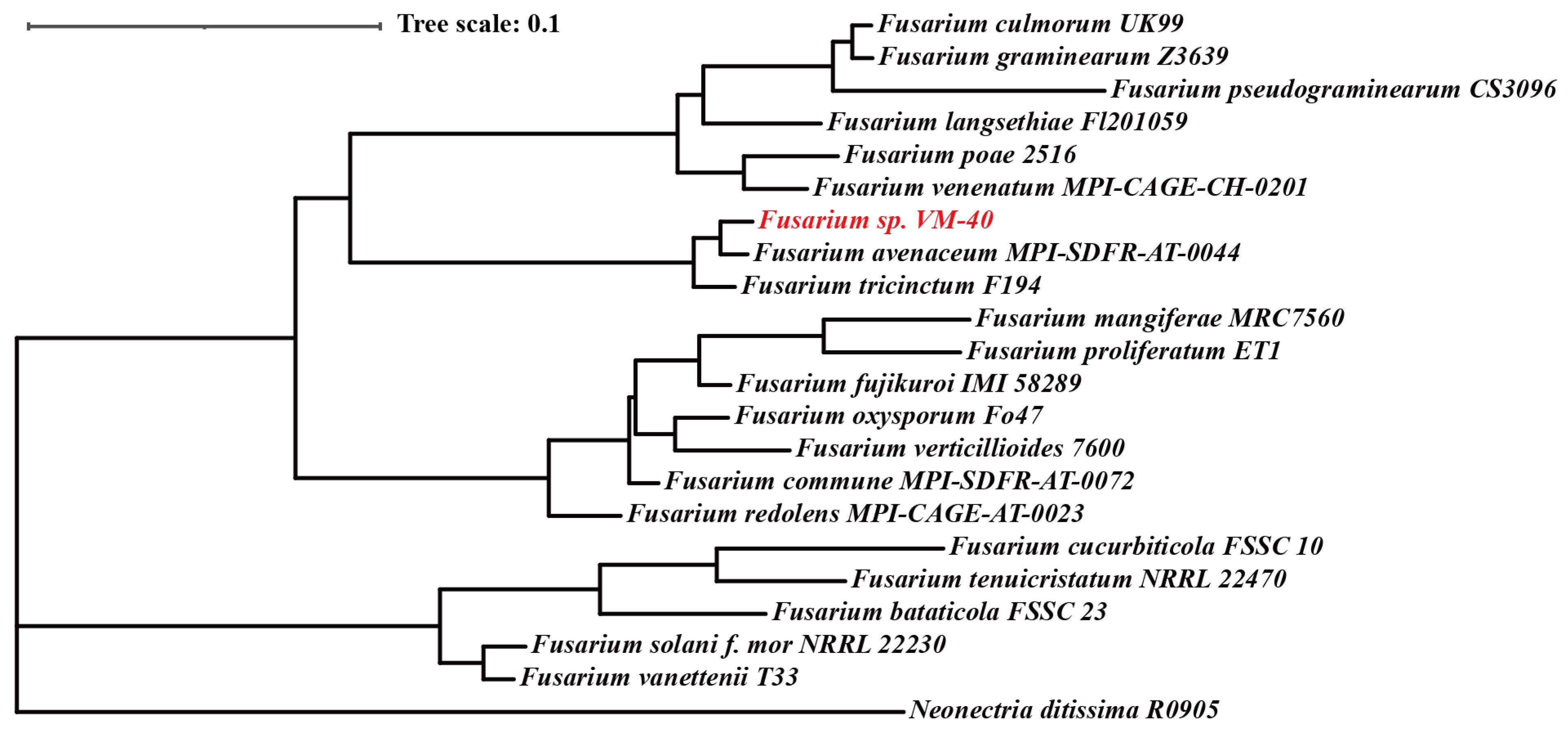
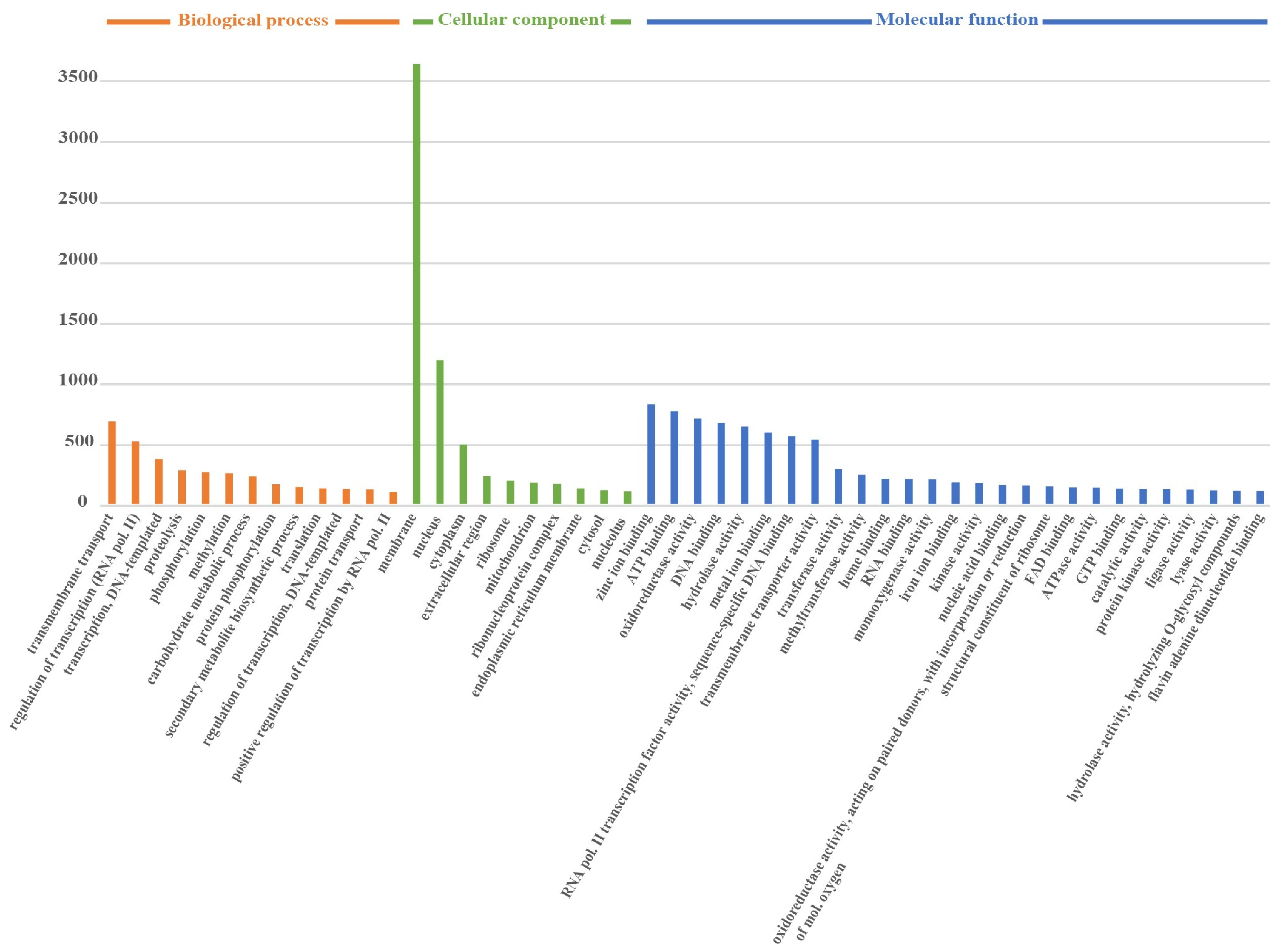

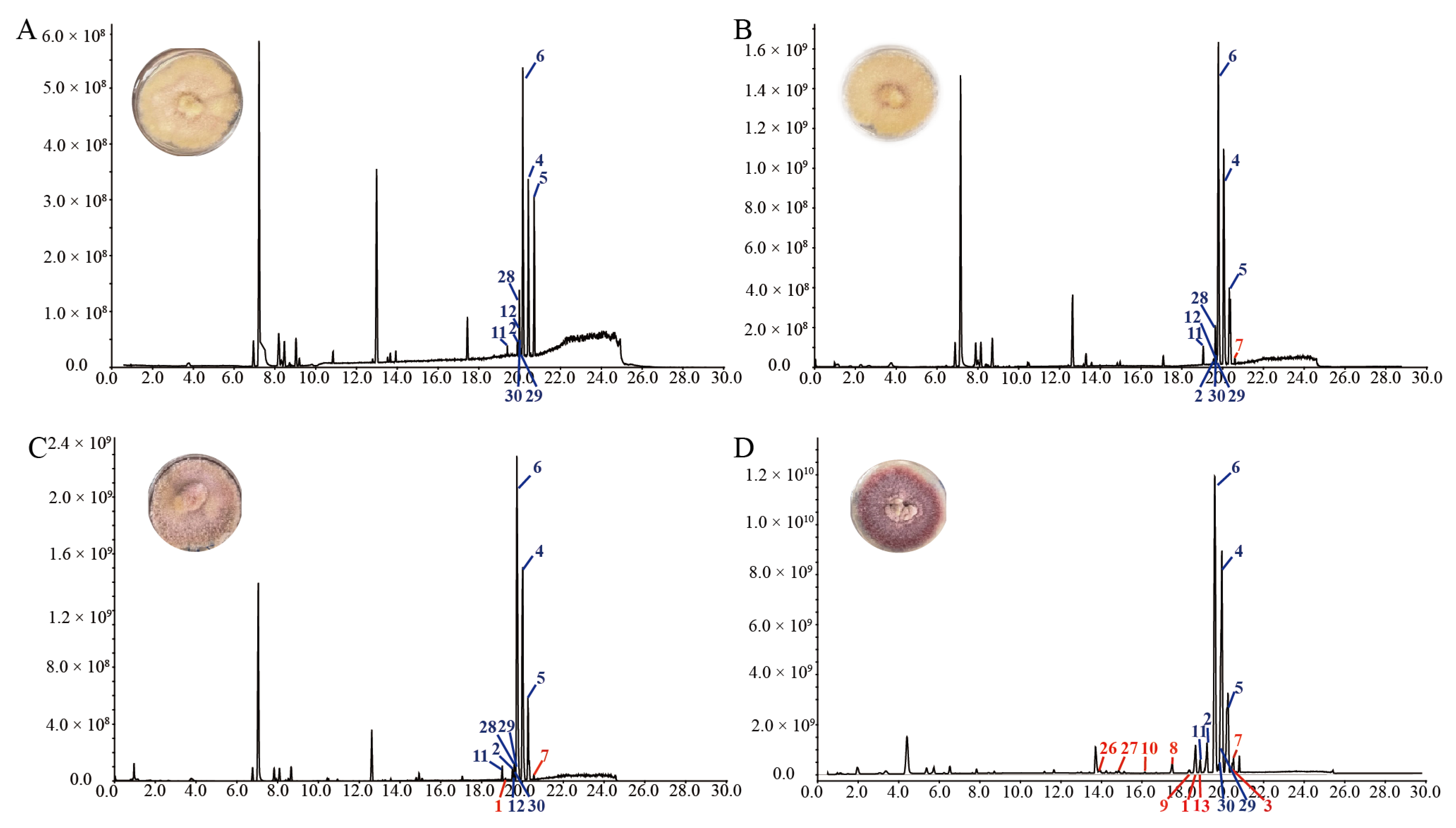
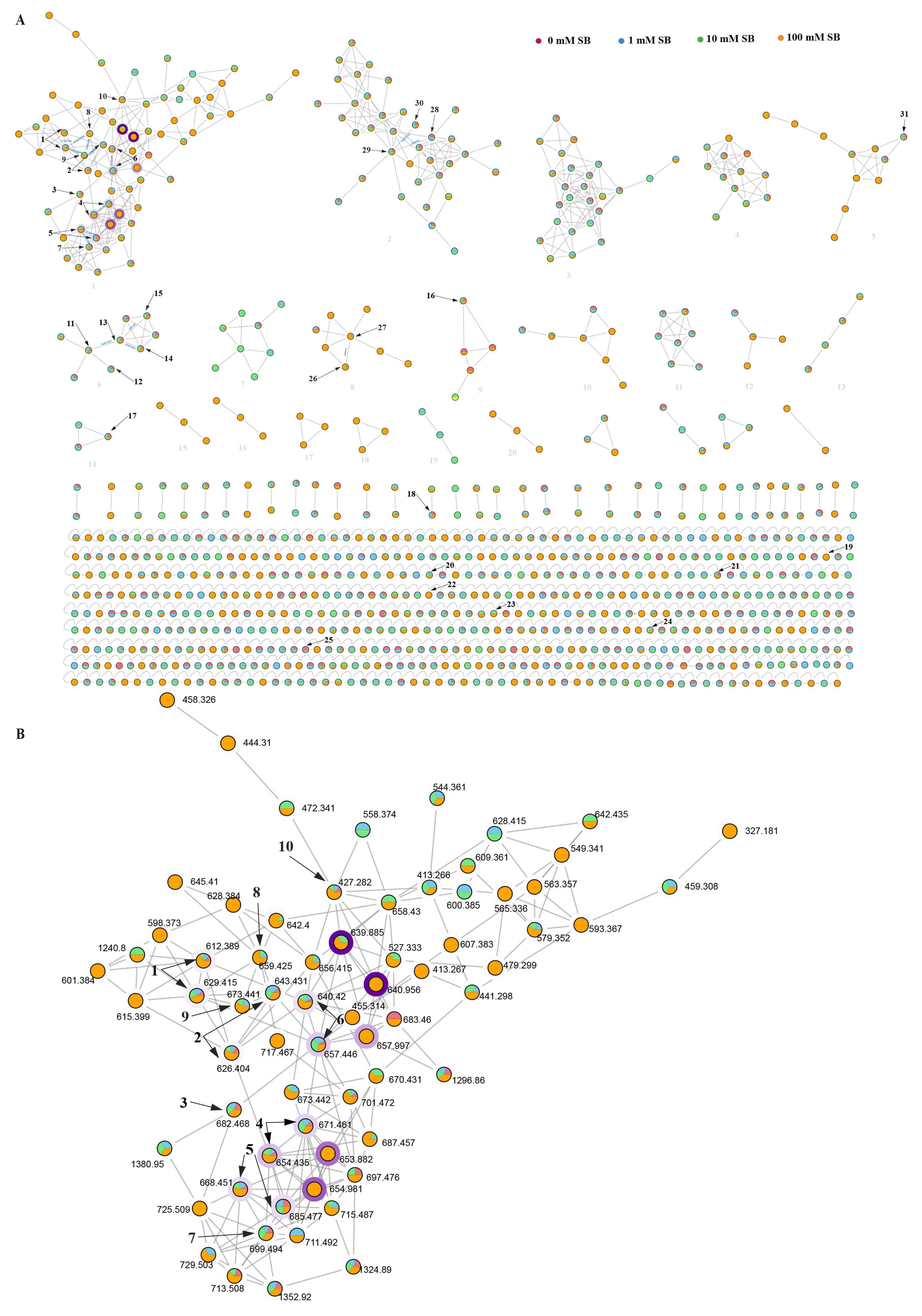
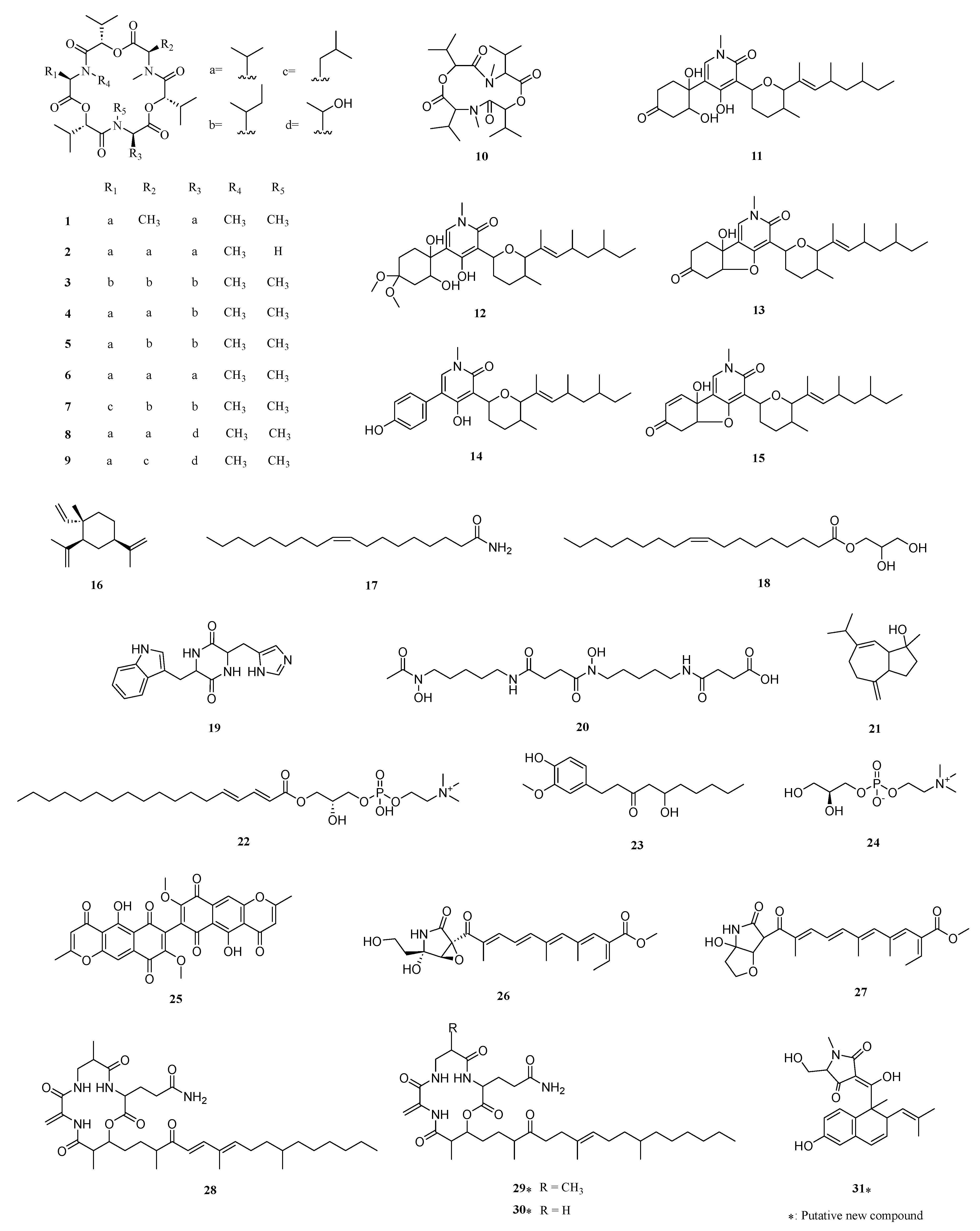
| Unfiltered | Filtered (>2 kb) | |
|---|---|---|
| No. of bases (Gb) | 6.1 | 5.0 |
| No. of reads | 1,997,205 | 866,843 |
| N50 (kb) | 5.5 | 7.3 |
| Mean read length (bp) | 3060.1 | 5784.4 |
| Mean read quality | 15.9 | 17.4 |
| Coverage | 100× | |
| Polishing steps | Racon + Medaka | |
| No. of contigs (≥50,000 bp) | 15 | |
| Genome size (Mb) | 40 | |
| GC (%) | 47.72 | |
| BUSCO (Ascomycota_odb10) (%) | 97.4 | |
| Number of the protein-coding genes | 13,546 | |
| tRNA genes | 320 | |
| rRNA genes | 80 | |
| Proteins with a predicted Pfam domain | 11,402 | |
| Proteins with CAZymes proteins | 691 | |
| Number | Metabolite Name | rt (min) | Experimental Mass (m/z) | Adduct | Molecular Formula | Molecular Weight | Theoretical Mass (m/z) | Mass Error (ppm) | MS2 Fragment Ions (m/z) | Samples | |||
|---|---|---|---|---|---|---|---|---|---|---|---|---|---|
| 0 mM a | 1 mM b | 10 mM c | 100 mM d | ||||||||||
| 1 | Enniatin J1 | 20.23/20.18/20.16/18.67 | 612.3829/612.3835/612.3834/612.3887 | [M + H]+ | C31H53N3O9 | 611.78 | 612.3866 | −5.97/−4.99/−5.15/3.50 | 499.3041, 399.2508, 286.1663, 214.1449, 196.1343, 186.1135, 168.1028, 86.0967 | t | t | + | + |
| 20.22/20.17/20.24/18.67 | 629.4094/629.4097/629.4100/629.4146 | [M + NH4]+ | 629.4131 | −5.88/−5.41/−4.93/2.38 | |||||||||
| 2 | Enniatin B2 | 20.56/20.60/20.48/19.21 | 626.3988/626.3989/626.3996/626.4046 | [M + H]+ | C32H55N3O9 | 625.80 | 626.4022 | −5.43/−5.27/−4.16/3.83 | 513.3196, 413.2675, 314.1979, 214.1449, 196.1344, 186.1500, 86.0968 | + | + | + | + |
| 20.54/20.50/20.47/19.30 | 643.4251/643.4254/643.4252/643.4313 | [M + NH4]+ | 643.4288 | −5.68/−5.21/−5.52/3.96 | |||||||||
| 3 | Enniatin A | 21.66/21.60/21.57/20.51 | 682.4611/682.4611/682.4614/682.4680 | [M + H]+ | C36H63N3O9 | 681.91 | 682.4648 | −5.43/−5.43/−4.99/4.68 | 555.3663, 455.3137, 328.2134, 228.1606, 210.1499, 200.1656, 100.1125 | t | t | t | + |
| 4 | Enniatin B1 | 21.24/21.01/21.07/19.96 | 671.4566/671.4568/671.4557/671.4609 | [M + NH4]+ | C34H59N3O9 | 653.86 | 671.4601 | −5.14/−4.84/−6.48/1.26 | 541.3507, 441.2983, 328.2135, 314.1975, 228.1606, 214.1448, 196.1343, 186.1498, 100.1125, 86.0967 | + | + | + | + |
| 21.06/21.02/21.18/19.91 | 654.4300/654.4301/654.4302/654.4352 | [M + H]+ | 654.4335 | −5.35/−5.20/−5.09/2.59 | |||||||||
| 5 | Enniatin A1 | 21.34/21.29/21.45/20.25 | 668.4450/668.4463/668.4456/668.4514 | [M + H]+ | C35H61N3O9 | 667.89 | 668.4491 | −6.21/−4.27/−5.32/3.36 | 541.3527, 441.2988, 328.2134, 314.1977, 228.1606, 210.1500, 196.1343, 100.1125, 86.0967 | + | + | + | + |
| 21.51/21.46/21.35/20.22 | 685.4721/685.4723/685.4711/685.4771 | [M + NH4]+ | 685.4757 | −5.26/−4.96/−6.72/2.04 | |||||||||
| 6 | Enniatin B | 20.79/20.76/20.73/19.58 | 657.4408/657.4412/657.4412/657.4459 | [M + NH4]+ | C33H57N3O9 | 639.83 | 657.4444 | −5.48/−4.87/−4.87/2.27 | 587.0684, 527.3361, 314.1976, 214.1449, 196.1343, 186.1499, 86.0967 | + | + | + | + |
| 20.79/20.76/20.73/19.56 | 640.4142/640.4145/640.4146/640.4203 | [M + H]+ | 640.4179 | −5.71/−5.24/−5.08/3.82 | |||||||||
| 7 | Enniatin F | 21.60/21.62/21.62/20.45 | 699.4878/699.4882/699.4880/699.4939 | [M + NH4]+ | C36H63N3O9 | 681.91 | 699.4914 | −5.08/−4.51/−4.79/3.64 | 555.3675, 455.3140, 328.2133, 228.1606, 210.1500, 200.1655, 182.1548, 100.1125 | t | + | + | + |
| 8 | Enniatin P1 | 19.55/17.54 | 659.4203/659.4255 | [M + NH4]+ | C32H55N3O10 | 641.80 | 659.4237 | −5.11/2.78 | 642.3979, 624.3943, 529.3160, 511.3055, 429.2618, 411.2516, 314.1987, 298.1658, 214.1449, 196.1343, 180.1029, 154.0871, 86.0968 | - | - | t | + |
| 9 | Enniatin P2 | 19.98/20.06/18.30 | 673.4358/673.4359/673.4421 | [M + NH4]+ | C33H57N3O10 | 655.83 | 673.4393 | −5.22/−5.08/4.13 | 656.4175, 610.4143, 556.3628, 511.3056, 425.2678, 298.1663, 210.1500, 196.1344, 100.1125, 86.0968 | - | t | t | + |
| 10 | 3,6,9,12-tetraisopropyl-4,10-dimethyl-1,7-dioxa-4,10-diazacyclododecane-2,5,8,11-tetraone | 18.18/18.12/18.09/16.15 | 427.2787/427.2791/427.2788/427.2823 | [M + H]+ | C22H38N2O6 | 426.55 | 427.2814 | −6.23/−5.29/−5.99/2.205 | 314.1976, 214.1449, 186.1498, 86.0967 | t | t | t | + |
| 11 | Oxysporidinone | 20.07/20.05/20.05/18.97 | 490.3148/490.3143/490.3145/490.3190 | [M + H]+ | C28H43NO6 | 489.65 | 490.3174 | −5.33/−6.35/−5.94/3.24 | 472.3093, 454.2981, 436.2867, 274.1088, 256.0981, 230.0824, 123.1174 | + | + | + | + |
| 12 | Dimethyl ketal of oxysporidinone | 20.70/20.66/20.66 | 536.3564/536.3562/536.3561 | [M + H]+ | C30H49NO7 | 535.72 | 536.3593 | −5.36/−5.74/−5.92 | 468.3091, 450.2992, 338.1736, 288.1230, 312.1579, 270.1112, 244.0954, 232.0956 | t | t | t | - |
| 13 | 4,6′-Anhydrooxysporidinone | 19.95/19.91/20.08/18.84 | 472.3043/472.3041/472.3043/472.3081 | [M + H]+ | C28H41NO5 | 471.64 | 472.3068 | −5.39/−5.82/−5.39/2.65 | 472.3089, 454.2981, 436.2873, 342.1718, 248.0931, 230.0825 | t | t | t | t |
| 14 | Sambutoxin | 20.99/20.98/20.96/20.13 | 454.2935/454.2934/454.2936/454.2971 | [M + H]+ | C28H39NO4 | 453.62 | 454.2963 | −6.12/−6.34/−5.90/1.80 | 436.2828, 324.1573, 298.1418, 256.0955, 230.0800, 218.0806, 175.1473, 137.1315, 123.1161, 109.1006, 95.0850, | t | t | t | t |
| 15 | (E)-4-(6-(4,6-dimethyloct-2-en-2-yl)-5-methyltetrahydro-2H-pyran-2-yl)-9a-hydroxy-2-methyl-2,5a,6,9a-tetrahydrobenzofuro[3,2-c]pyridine-3,7-dione | 20.18/20.16/20.16/19.24 | 470.2885/470.2882/470.2885/470.2921 | [M + H]+ | C28H39NO5 | 469.62 | 470.2912 | −5.73/−6.37/−5.73/1.92 | 452.2769, 340.1533, 314.1364, 312.1214, 272.090, 246.0748, 228.0638, 137.1320, 109.1107, 95.0850, 69.0696 | t | t | t | t |
| 16 | Beta-elemene | 15.09/15.05/15.02/13.09 | 205.1943/205.1944/205.1944/205.1960 | [M + H]+ | C15H24 | 204.36 | 205.1962 | −9.13/−8.65/−8.65/−0.85 | 149.1317, 135.1160, 121.1004, 109.1004, 95.0849 | t | t | t | t |
| 17 | 9-(Z)-octadecenamide | 21.40/21.40/21.39/20.79 | 563.5490/563.5490/563.5490/563.5538 | [2M + H]+ | C18H35NO | 281.48 | 563.5521 | −5.51/−5.51/−5.51/3.01 | 282.2775, 265.2510, 247,2409, 135.1160, 97.1006, 83.0850, 69.0696 | t | t | t | t |
| 18 | Monoolein | 21.39/21.36/20.65 | 357.2981/357.2981//357.3013 | [M + H]+ | C21H40O4 | 356.55 | 357.3010 | −8.21/−8.21/0.75 | 339.2882, 265.2509, 247.2408, 177.1627, 149.1317, 135.1161, 121.1006, 95.0850, 83.0851, 69.0696, 57.0699 | t | t | - | t |
| 19 | 3-(1H-imidazol-4-ylmethyl)-6-(1H-indol-3-ylmethyl)-2,5-piperazinedione | 1.74 | 324.1471 | [M + H]+ | C17H17N5O2 | 323.36 | 324.1466 | 1.55 | 195.0888, 159.0928, 130.0661, 110.0717, 71.4404 | - | - | - | t |
| 20 | 3,14-dihydroxy-2,10,13,21-tetraoxo-3,9,14,20-tetraazatetracosan-24-oic acid | 19.37/19.34 | 478.2910/478.2902 | [M + NH4]+ | C20H36N4O8 | 460.53 | 478.2882 | 5.78/4.10 | 337.2721, 175.1486, 95.0851, 69.0697 | - | t | t | - |
| 21 | 1-methyl-4-methylidene-7-(propan-2-yl)-1,2,3,3a,4,5,6,8a-octahydroazulen-1-ol | 13.57/13.52/13.48/13.11.36 | 203.1787/203.1787/203.1786/203.1803 | [M-H2O + H]+ | C15H24O | 220.36 | 203.1805 | −8.98/−8.98/−9.47/−1.10 | 161.1314, 147.1161, 133.1006, 117.0692, 109.1003, 95.0850, 83.0852, 69.6548 | t | t | t | t |
| 22 | PC(18:2/0:0) | 18.83 | 520.3424 | M+ | C26H51NO7P+ | 520.67 | 520.3409 | 2.95 | 184.0744, 123.0812, 86.0968 | - | - | - | t |
| 23 | 5-hydroxy-1-(4-hydroxy-3-methoxyphenyl)decan-3-one | 16.44/15.32 | 295.1891/295.1916 | [M + H]+ | C17H26O4 | 294.39 | 295.1915 | −8.07/0.40 | 239.1278, 221.1161, 193.1218, 139.1109, 123.0797, 101.0229, 85.0279 | - | - | t | t |
| 24 | SN-Glycero-3-Phosphocholine | 0.95/0.92/0.53 | 258.1090/258.1089/258.1114 | [M + H]+ | C8H20NO6P | 257.22 | 258.1112 | −8.51/−8.90/0.79 | 258.1088, 184.0724, 124.9991, 104.1064, 86.0958 | - | t | t | t |
| 25 | Aurofusarin | 17.57/17.68/14.59 | 571.0853/571.0852/571.0903 | [M + H]+ | C30H18O12 | 570.46 | 571.0882 | −5.08/−5.25/3.68 | 556.0668, 541.0425, 528.0727, 511.0689, 484.0820 | t | t | - | t |
| 26 | Fusarin C | 13.88 | 454.1854 | [M + Na]+ | C23H29NO7 | 431.49 | 454.1847 | 1.49 | 426.1905, 335.1276, 290.1012, 267.1372, 250.0722, 222.0664, 69.4139 | t | - | t | + |
| 27 | Lucilactaene | 16.68/14.85 | 438.1874/438.1908 | [M + Na]+ | C23H29NO6 | 415.49 | 438.1898 | −5.49/2.27 | 274.1065 | - | - | t | + |
| 28 | Fusaristatin A | 20.67/20.66/20.65 | 659.4354/659.4355/659.4357 | [M + H]+ | C36H58N4O7 | 658.43 | 659.4389 | −5.34/−5.19/−4.89 | 428.3155, 377.3022, 359.2934, 331.2983, 303.2669, 232.1282 | + | + | + | - |
| 29 | (E)-3-(6,13-dimethyl-10-methylene-2,5,9,12-tetraoxo-14-(3,7,11-trimethyl-4-oxoheptadec-7-en-1-yl)-1-oxa-4,8,11-triazacyclotetradecan-3-yl)propanamide | 20.73/20.72/20.72/19.85 | 661.4513/661.4512/661.4511/661.4564 | [M + H]+ | C36H60N4O7 | 660.45 | 661.4545 | −4.95/−5.10/−5.25/2.76 | 430.3304, 402.3347, 359.2926, 331.2975, 303.2666, 232.1280 | + | + | + | + |
| 30 | (E)-3-(13-methyl-10-methylene-2,5,9,12-tetraoxo-14-(3,7,11-trimethyl-4-oxoheptadec-7-en-1-yl)-1-oxa-4,8,11-triazacyclotetradecan-3-yl)propanamide | 20.70/20.68/20.68/19.86 | 647.4356/647.4357/647.4356/647.4410 | [M + H]+ | C35H58N4O7 | 646.87 | 647.4389 | −5.13/−4.98/ −5.13/3.21 | 430.3298, 402.3349, 359.2927, 303.2666, 218.1126, 147.0756 | t | t | t | + |
| 31 | (Z)-3-(hydroxy(6-hydroxy-1-methyl-2-(2-methylprop-1-en-1-yl)-1,2-dihydronaphthalen-1-yl)methylene)-5-(hydroxymethyl)-1-methylpyrrolidine-2,4-dione | 14.82/14,79/14.79/14.84 | 384.1791/384.1791/384.1793/384.1825 | [M + H]+ | C22H25NO5 | 383.44 | 384.1816 | −6.63/−6.63/−6.11/2.22 | 384.1824, 366.1726, 338.1772, 241.1237, 213.1287 | t | t | t | t |
Disclaimer/Publisher’s Note: The statements, opinions and data contained in all publications are solely those of the individual author(s) and contributor(s) and not of MDPI and/or the editor(s). MDPI and/or the editor(s) disclaim responsibility for any injury to people or property resulting from any ideas, methods, instructions or products referred to in the content. |
© 2023 by the authors. Licensee MDPI, Basel, Switzerland. This article is an open access article distributed under the terms and conditions of the Creative Commons Attribution (CC BY) license (https://creativecommons.org/licenses/by/4.0/).
Share and Cite
He, T.; Li, X.; Iacovelli, R.; Hackl, T.; Haslinger, K. Genomic and Metabolomic Analysis of the Endophytic Fungus Fusarium sp. VM-40 Isolated from the Medicinal Plant Vinca minor. J. Fungi 2023, 9, 704. https://doi.org/10.3390/jof9070704
He T, Li X, Iacovelli R, Hackl T, Haslinger K. Genomic and Metabolomic Analysis of the Endophytic Fungus Fusarium sp. VM-40 Isolated from the Medicinal Plant Vinca minor. Journal of Fungi. 2023; 9(7):704. https://doi.org/10.3390/jof9070704
Chicago/Turabian StyleHe, Ting, Xiao Li, Riccardo Iacovelli, Thomas Hackl, and Kristina Haslinger. 2023. "Genomic and Metabolomic Analysis of the Endophytic Fungus Fusarium sp. VM-40 Isolated from the Medicinal Plant Vinca minor" Journal of Fungi 9, no. 7: 704. https://doi.org/10.3390/jof9070704
APA StyleHe, T., Li, X., Iacovelli, R., Hackl, T., & Haslinger, K. (2023). Genomic and Metabolomic Analysis of the Endophytic Fungus Fusarium sp. VM-40 Isolated from the Medicinal Plant Vinca minor. Journal of Fungi, 9(7), 704. https://doi.org/10.3390/jof9070704






